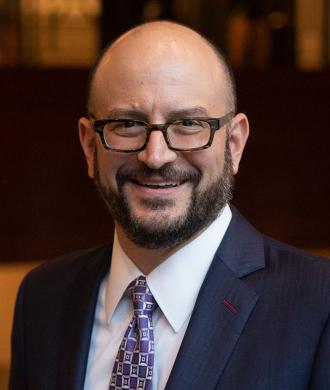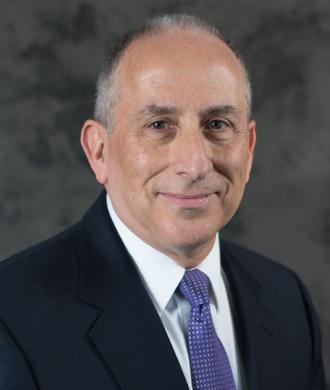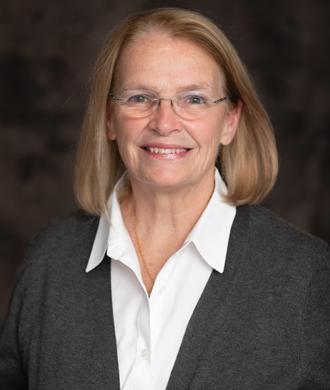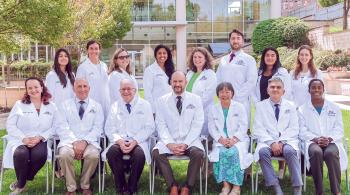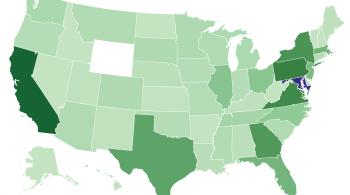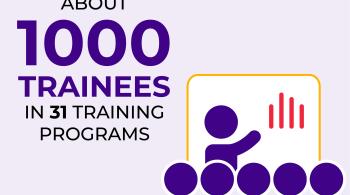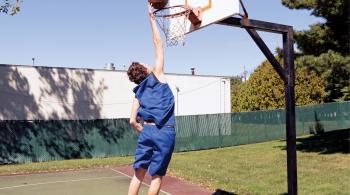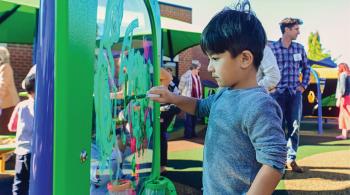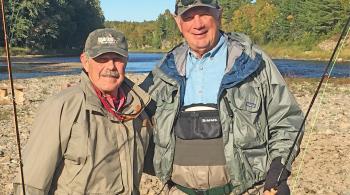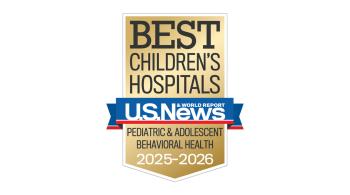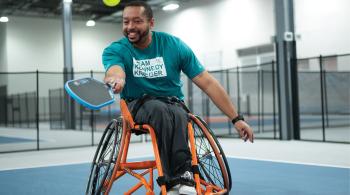On this ninth episode of Your Child's Brain, autism is discussed including its diagnosis, early signs and interventions.
Speakers include:
Additional resources on Autism:
- Early Signs of Autism training video
- Center for Autism and Related Disorders at Kennedy Krieger Institute
- CDC Learn the Signs
- Pathfinders for Autism
- Autism Speaks
- Simons Foundation
- Autism Society of America
Learn More About Our Featured Speakers
Learn More About Our Featured Speakers
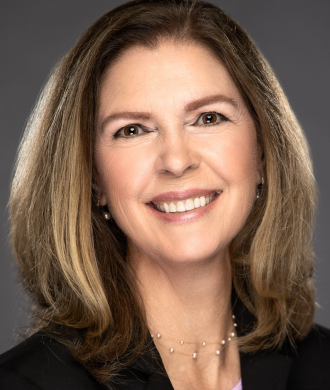
Rebecca
Landa
,
PhD, CCC-SLP
View Episode Transcription
Brad Schlaggar (BS): Welcome to Your Child's Brain, a podcast series produced by Kennedy Krieger Institute with assistance from WYPR. I'm Dr. Brad Schlaggar, President and CEO Kennedy Krieger Institute and I'm a pediatric neurologist. Today, we'll be discussing autism, which is a large and complex topic for which we will be devoting multiple episodes of Your Child's Brain. I'm joined today by doctors Paul Lipkin, Rebecca Landa, and Mary Leppert. Dr. Lipkin is the Developmental Pediatrician and the Director of Medical Outpatient Services at Kennedy Krieger and he is Professor of Pediatrics at the Johns Hopkins University School of Medicine. Dr. Landa, is a Developmental Scientist and Speech Pathologist, and a Vice President at Kennedy Krieger, where she is executive director and founder of our Center for Autism and Related Disorders and she's a professor of Psychiatry and Behavioral Sciences at Johns Hopkins. Dr. Mary Leppert is the Director of the Center for Development and Learning at Kennedy Krieger, and she's an Associate Professor of Pediatrics also at Johns Hopkins. Welcome Paul, Becky, and Mary. Now, before we get started, I'd like to acknowledge that in the autism advocacy community, there are varying perspectives on language. Some prefer the use of person first language, for example, Johnny is a person with autism, and others prefer the use of identity first language. For example, Sally is an autistic person. Now at Kennedy Krieger, we recognize and respect these perspectives and take no position on which perspective is preferable. We think that the most inclusive approach is to respect the range of perspectives, use the language interchangeably and whenever possible, ask an individual how they would like to be identified. With that, let's get started. Mary, let's begin with you. Big broad topic. What is autism? What are the characteristics of someone with autism? What causes it? Maybe you can address some of the myths regarding cause as well.
Mary Leppert (ML):Thank you, Brad. Autism is a broad topic as you said, but in general, it's something that is manifest in very early childhood by atypical manifestations of communication, of social interaction, or by very limited or restricted or atypical play and repetitive behavior. You asked what we know about the cause of autism, and what we know is constantly evolving. As we learn more about genetics, we're finding more and more associations every day between autism and genetic findings. We're also looking at evidence of conditions and about moms and pregnancy that may contribute or other conditions like prematurity that have an association with autism as well. There's a lot of research also going on about some of the environmental influences like pollutants and stuff but that's a big open question mark. I think we know more now about what doesn't cause autism than we know about what does. We know that the early theories that a cold mom or refrigerator mom as I used to call them, is that myth was dispelled very quickly, I think. In the last few decades, really it's been very clear that the myth that autism causes are that vaccines cause autism is completely been dispelled. There's good clear evidence that that is not a cause.
BS: Well, sitting with you, Mary, let's then talk a bit about epidemiology. When we all got started, it was considered a rare diagnosis. I can remember being a medical student in the mid 80s and hearing one in five to 10,000. That's clearly not the case these days. What is the prevalence and why is it higher now than when we all got started?
ML: There's no denying the increasing prevalence. About 20 years ago, America started tracking prevalence and we went from one in about 300 20 years ago to now one in 44 children are diagnosed with autism. I would make sure that we recognize so that in the 11 states that are monitoring the condition, there's a lot of variability in that prevalence, and that's reflected by the international community that shows very high prevalence when in 35 or so in some countries to one in 150 in others. I think internationally we think the average is about one in 100 children. Certainly a big jump. What's causing those? Well, it's not entirely clear what's causing them. What is clear is that there are a number of things that may be contributing. Those contributions might include a broadening of the diagnostic criteria through different iterations of the manual that we use for diagnoses. I think we're also seeing more specific and more accurate testing tools to help us with diagnoses. We certainly know that the media presence has raised the awareness of autism as have some very helpful public health campaigns like CDC's early signs program. Finally, had talked to Paul in on this one, but the American Academy of Pediatrics is really strongly recommending routine screening with a specific autism tool at 18 and 24 months. I think it's the constellation of a number of these things that are all contributing to the rising tide of autism in our country.
BS: Thanks Mary. Becky, this is for you. How early do children show signs that they might be attributed to autism? How young can a child be diagnosed and other conditions that might masquerade as autism but are something else.
Rebecca Landa (RL): Right. Most children begin to manifest enough symptoms of autism to be able to be diagnosed sometime between the first and third birthday. Our research shows that when children are diagnosed with autism at age 18 months, it's about 80 percent stable, at least through the third birthday. I wanted to also mention that there are multiple developmental pathways to autism and this can be confusing to parents. For some children, there is development of the expected social and communication milestones with reasonably good quality, at least into the second year of life. Then sometime between the first and second birthday, those skills begin to diminish and the atypical behaviors that Dr. Leppert mentioned begin to arise. For other children when they hit 12 months of age, they're not starting to show this kinds of social and communication skills that we would expect and they already have some of these atypical behaviors and patterns. Parents need to be on the lookout for both kinds of patterns. In terms of other conditions that could appear to be autism, some of the most common would include a global developmental delay, attention deficit hyperactivity disorder, hearing impairment, or anxiety.
BS: Paul, picking up on the points Becky just made about what a parent might be able to discern, what signs do you think a parent or caregiver might notice that may indicate a child should be evaluated for autism?
Paul Lipkin (PL): What Dr. Landa just pointed out were to key areas; problems in the way a child communicates with others, and I'm using communication in a broad term, not just words, as well as the way a child interact socially and engages with other people. The kind of signs that we're looking for are whether a child will follow a pointing gesture. If you point to an object and child's not looking at that object that's concern. Similarly, if the child themselves are not gesturing to try to communicate, that also is important. One of the really early ones that sometimes show some concern is your child not putting your arms out to be lifted up. It's that interaction and that nonverbal behavior that becomes a big issue. Then following directions, whether these be verbal directions, such as bring me the toy, or be nonverbal directions, such as putting out your hand, those are all some of the early concerns that we have. Finally the solvent signage, so the words, it's just a response to words and engagement in nonverbal cues just as much. One other one has to do with looking at someone's face and having that eye contact that we expect a normal conversation. Those are all potential signs and things that may elicit concern.
BS: Paul. This one's for you. Part of the evaluation includes the physician thinking through what we call a differential diagnosis. What are all the different things that could be going on? What do you recommend for a pediatrician for making sure that that medical evaluation takes place?
PL: Thank you, Brad. When the parent speaks to the pediatrician and there are concerns by the parent or the pediatrician about a child having autism spectrum disorder, there are some medical problems that needs to be thought through and possibly tested for. For example, some children will have a genetic problem or a neurologic abnormalities and we'd like the pediatricians to start helping the families in terms of evaluating for those problems that may accompany autism spectrum disorder.
BS: Mary, when a parent sees those, what's the next step? What should they do if they are concerned?
ML: Thanks, Brad. That's a good question because I think it's asked too often and it's a very simple answer. The answer is you start with your pediatrician or your pediatric provider for your child. In doing that, my suggestion would be that you go to your pediatrician not just with vague concerns about development or is this autism? But with specific observations about your child. As Paul said, my child isn't looking at me. My child ignores me when I call, but I know they hear when I whisper, or my child doesn't seem to interact with or seems indifferent to interaction when he encounters other people. Having specific observations, I think will help push the pediatrician along down the evaluation pathway.
BS: A moment ago, Mary referenced your work with the American Academy of Pediatrics and the CDC on building tools to help with screening. So could you speak to that work including how the work on milestones relates to the advocacy for autism and other important screenings?
PL: Yeah, I'd be glad to. The process for a child to be recognized and to be identified with autism or other related disorders is a step-wise process and usually begins with parent showing some concerns with some of the signs that we just talked about. But how does the parent know what to look for? Well, there are what we call developmental milestones that have been worked on for decades and are always being refined. The best place for parents to look at standards for developmental milestones, for guidance around developmental milestones when a child achieves certain skills, is available through the CDC at the Learn the Signs Act Early website and actually just this month, they've been recently updated with new guidance around that. Parents can follow along on their children's development through these tools, there's a milestone tracker app for a phone that parents can download for free, also produced by the CDC. That's the parent piece. But as nicely introduced by Mary, when a parent sees the concern, what's their next step? The next step is to speak to a professional. This could be their pediatric health care professional, or it could be an early childhood professional, a daycare professional, because the next step when they have these concerns is for a child to have specific screening to see if they do have a problem. In pediatrics, all children should be screened for autism with or without a concern at 18 and 24 months of age, with a standardized tool. The one that's been most commonly used has been the M-CHAT, but there are always new ones that are being developed to try to improve upon our screening. Again at 18 and 24 months of age or when there is a concern. Then when a concern is identified through surveillance, through milestones, what we call developmental surveillance, or through screening, the next step might be for a child to see specialized professionals to seek out further assistance.
BS: You know when I think about the three of you and over the last couple of decades that the consequential work that you've all done in all around the idea of early identification, screening, capacity-building so that pediatricians and other pediatric providers are doing that work and getting more children recognized early, it's really enormous, the contributions that you've all made. Let's go to Becky and talk about Becky as an autism specialist, not a physician but a speech-language pathologist by training and a developmental scientist, as we discussed. Can you take us through how an autism specialist looks at the evaluation? How is autism treated after you've made the diagnosis and what does intervention really mean and why does it matter?
RL: Sure. I'd be happy to. First of all, when a child presents for a special evaluation to decide whether or not a child is showing signs of autism and should receive an autism diagnosis, there's two primary parts. The first part is getting information from the parents. We want to understand specifically their concerns, get information about the medical and developmental history, and then to understand what's happening right now with a child's ability to engage socially, like responding to their name, social turn-taking, how functional and imaginative is their play, how are they handling changes in their routine, how are they reacting to different sensory experiences and how are they communicating? Then the specialist is going to want to understand how the child functions in their everyday life, like dressing and eating and so forth. Then there's the direct assessment by the specialist and there's two parts to this. One part is the part that specifically gives children opportunities to engage in behaviors that will lead the specialists to either think that the child is developing the social and communication skills as expected and whether or not these atypical behaviors that we've been describing are present, insufficient, intensity and severity to warrant a diagnosis. The second part of the direct assessment has to do with testing the child's cognition and language skills to give us a yardstick against which to estimate whether or not the child's communication, play, and social interaction is what we would expect for the child's overall developmental ability. Now, whether or not the child is diagnosed with autism, if there are delays, a referral is going to be made for intervention. In intervention, a therapist is going to work with parents and they're going to use the evaluation results to design an individualized set of goals and teaching strategies for the child's needs and the family's priorities. Here, the therapists are going to use the child's strengths to help the child learn to use their existing skills in new ways and to build new and more complex skills. It's really important for parents to be involved in this because when parents are learning these strategies, like not anticipating their child's needs, modeling for their child certain kinds of things they want their child to learn to do, building in the child's interests into the interaction to motivate the child's engagement and rewarding the child's attempts. When these things are happening from the parent's engagement, the child is getting a lot of experiences where they can build new knowledge and skills. Intervention is important because it helps the child's brain build new, more efficient, and well-connected networks, and also, the more children learn, the more they make sense of the world around them, and the more they engage in that world.
BS: Thanks, Becky. Mary, there's some other questions that we could ask about the epidemiology, and that relates to disparities potential. Are there disparities in the age, sex, race, for example, in autism diagnoses?
ML: Data that is changing as well, but yes, there are disparities. Autism occurs 3-4 times more often in boys than it does in girls. Until recent data, there had been a higher prevalence in non-Hispanic white children in the United States being diagnosed with autism, but those disparities are shrinking. The 2018 data shows us that the rates among non-Hispanic white, Hispanic, black, and Pacific Islander children is really leveling off. The other thing that the new data is showing us is that children are being diagnosed earlier than they had been in previous assessments of the data. A higher number diagnosed at four, and in those diagnosed at four, 75 percent have been diagnosed by age 3. We're really moving the needle down.
BS: Mary, staying with you, what should a child's pediatric clinician understand about autism? We just talked about intervention and it's really driven by specialists and in an often a multi-disciplinary way. Back to the pediatric clinician, what should that clinician know about autism and how to help families?
ML: I think what the pediatricians need to know first and foremost is that they're well-trained and that often they can make that diagnosis. They should feel empowered to make the diagnosis of autism in a child who's clearly showing diagnostic criteria. They should know and be aware of the resources in their community to guide that child into early intervention services. We spend a lot of time coaching primary care doctors and pediatrics to do this, and I will till you that the truth of practices that often the diagnosis isn't clear and it's also not clear what services children need or where to get them. I would really encourage those primary care pediatricians and pediatric providers to join programs that support them in the identification and management of children, not just with autism, but developmental and behavioral disorders in early childhood. There are autism ECHOs going on in the United States and here in Maryland, the state has supported an ECHO Program that's pediatric primary care providers and early childhood stakeholders. It's a longitudinal educational opportunity that guides practice with people in multi-disciplinary clinics, and it guides the practice of the pediatricians and the early childhood people. It builds a collaboration between those stakeholders that encourages a coordinated plan for the child in their local community.
BS: Mary, can you just quickly define ECHO for those who may not know?
ML: ECHO is a program called extension of community health outcomes. It's an educational program that is seated usually in an academic institute where a team of experts meet weekly or every other week with primary care providers on a specific topic to guide their practice and increase their knowledge and confidence and carrying for specific disorders.
BS: I think what we can do is put a link to ECHO in our resources page. Let's move to the question to Becky. Is there harm in a late diagnosis? Quickly, what happens if a child is diagnosed late?
RL: Here's the good news. Learning happens in the brain and the brain is plastic. While the brain is more plastic, meaning that brain can do more compensation when parts that are supposed to be doing certain kinds of learning aren't doing it in a natural way. While it's greater in earlier childhood, it is there for a lifetime. Children who enter intervention at later ages are still going to learn.
BS: Becky, sticking with you, let's talk about reliable resources for parents and caregivers. You posted a video on YouTube back in 2013, Early Signs of Autism, that's been viewed well over four million times as an example of a reliable resource. Can you talk about that video briefly and what you consider to be reliable and substantive information. I'll say that we can put links to such resources on our page as well.
RL: Yes. Thanks, Brad. This is a free video and it's called bringing the early signs of autism spectrum disorder into focus, and it's in multiple languages. This is a nine-minute tutorial that shows pairs of videos of one year olds who do and do not show signs of autism. They are narrated to help people understand what they're seeing and why what they're seeing is an indicator or not of autism. Because this has been so helpful to people, we developed a screener for social communication, interaction and play called The Skips that we're now establishing the cutoffs for. We're inviting families to participate, whether or not they have concerns about their child's development, to view these videos within the screener and then answer questions about their child's development. There are also great resources on the Card.KennedyKrieger.org website under our outreach and training that canvas a lot of topics pertaining to autism that people can listen to virtual presentations and get the handouts. We've already talked about the CDC learn the science act early, which is invaluable. There's also the 0-3 or infants and toddlers organizations in every state in the union, where children get free assessments and free intervention. Now, there's also organizations like Path Finders for Autism, which is a Maryland centric organization, but also national organizations like Autism Speaks, the Simons Foundation Spark program, which by the way has information for parents written by Kennedy Krieger experts, but also the Autism Society of America, which has Chapters across the country. I'll leave it at that and know that we'll also put other resources up on the resource list that I didn't have a chance to mention.
BS: Thank you, Becky, and thank you all three of you. As I mentioned at the outset, autism is a large and complex topic and it affects people throughout the lifespan. We're going to devote several podcasts to this topic. In future episodes, we'll cover the middle and high school years, translation from school to work or community life, challenges and inequities that individuals with autism face, among other significant issues. Please check out our entire library of topics on Your Child's Brain. WYPR.org, and KennedyKrieger.org, or wherever you get your podcasts. You've been listening to Your Child's Brain. Your Child's Brain is produced by Kennedy Krieger Institute with assistance for WYPR and producer Spencer Bryan. Please join us next time as we examine the mysteries of Your Child's Brain. [MUSIC]

